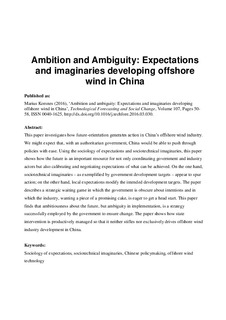| dc.contributor.author | Korsnes, Marius | |
| dc.date.accessioned | 2017-11-21T15:37:54Z | |
| dc.date.available | 2017-11-21T15:37:54Z | |
| dc.date.created | 2016-04-21T17:22:18Z | |
| dc.date.issued | 2016 | |
| dc.identifier.citation | Technological forecasting & social change. 2016, 107 50-58. | nb_NO |
| dc.identifier.issn | 0040-1625 | |
| dc.identifier.uri | http://hdl.handle.net/11250/2467416 | |
| dc.description.abstract | This paper investigates how future-orientation generates action in China's offshore wind industry. We might expect that, with an authoritarian government, China would be able to push through policies with ease. Using the sociology of expectations and sociotechnical imaginaries, this paper shows how the future is an important resource for not only coordinating government and industry actors but also calibrating and negotiating expectations of what can be achieved. On the one hand, sociotechnical imaginaries – as exemplified by government development targets – appear to spur action; on the other hand, local expectations modify the intended development targets. The paper describes a strategic waiting game in which the government is obscure about intentions and in which the industry, wanting a piece of a promising cake, is eager to get a head start. This paper finds that ambitiousness about the future, but ambiguity in implementation, is a strategy successfully employed by the government to ensure change. The paper shows how state intervention is productively managed so that it neither stifles nor exclusively drives offshore wind industry development in China. | nb_NO |
| dc.language.iso | eng | nb_NO |
| dc.publisher | Elsevier | nb_NO |
| dc.rights | Attribution-NonCommercial-NoDerivatives 4.0 Internasjonal | * |
| dc.rights.uri | http://creativecommons.org/licenses/by-nc-nd/4.0/deed.no | * |
| dc.title | Ambition and ambiguity: Expectations and imaginaries developing offshore wind in China | nb_NO |
| dc.type | Journal article | nb_NO |
| dc.type | Peer reviewed | nb_NO |
| dc.description.version | acceptedVersion | nb_NO |
| dc.source.pagenumber | 50-58 | nb_NO |
| dc.source.volume | 107 | nb_NO |
| dc.source.journal | Technological forecasting & social change | nb_NO |
| dc.identifier.doi | 10.1016/j.techfore.2016.03.030 | |
| dc.identifier.cristin | 1351835 | |
| dc.relation.project | Norges forskningsråd: 209697 | nb_NO |
| dc.description.localcode | © 2016. This is the authors’ accepted and refereed manuscript to the article. LOCKED until 13.4.2018 due to copyright restrictions. This manuscript version is made available under the CC-BY-NC-ND 4.0 license http://creativecommons.org/licenses/by-nc-nd/4.0/ | nb_NO |
| cristin.unitcode | 194,62,40,0 | |
| cristin.unitname | Institutt for tverrfaglige kulturstudier | |
| cristin.ispublished | true | |
| cristin.fulltext | original | |
| cristin.fulltext | postprint | |
| cristin.qualitycode | 2 | |

